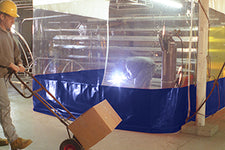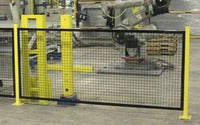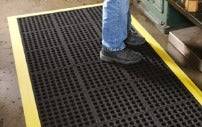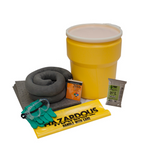Excessive noise has become a major health threat in industrial environments. It also contributes to low employee productivity, resulting in higher business costs and lower profitability. Therefore, successful industrial businesses are considering noise control a top priority. Using industrial noise control curtains are an effective way to make it possible.
Though installing sound curtains and noise blankets is an effective investment, it’s still a common concern for business owners or facility managers to ask the question, “Are these industrial noise control curtains worth the money?” Here’s the answer: Yes, if your industrial noise control curtains have an STC rating that matches your facility’s soundproofing requirements.
Not all sound curtains are made for a particular industrial facility. The efficacy of each sound curtain depends on its STC rating. So, how to choose industrial noise control curtains that deliver optimum soundproofing for your facility?
The solution is to understand the STC ratings to measure the power of your sound curtains. In this guide, we’ll elaborate on what an STC rating is and how to measure it to successfully implement noise control initiatives in your industrial settings.

What is an STC Rating?
Also called Sound Transmission Class, STC is a sound-measuring metric that evaluates the level of noise control in various industrial settings (such as construction sites, offices, manufacturing plants, warehousing units, and other places where sound has to be restricted as much as possible). It assesses the capacity of industrial noise control curtains and determines how well a noise control barrier can block sound.
Choosing between a high STC rating and a low STC rating depends on the unique noise control objectives of a business and the level of soundproofing required. To understand it in detail, let’s have a look at specific STC ratings and how they help control different types of noise:
STC 25
Made with single-layer materials, noise barriers with STC-25 rating are applicable in environments where the objective is to reduce unwanted, mild noise instead of complete soundproofing. While conversations are still audible, sound curtains or panels having this level of sound transmission can maintain a tranquil setting. These are suitable for reducing background noise in restaurants, temporary work zones, and warehouses.
STC 30
Constructed with fiberglass insulation, MLV, and absorptive fabrics, sound curtains within the range of STC 30 and STC 34 ratings are commonly used in industrial environments. These industrial noise control curtains are preferred in workshops, manufacturing floors, and shipping docks where the objective is to reduce ambient noise (instead of eliminating it). Using these curtains enables facility managers to reduce the overall volume to an extent that the extra noise being produced from heavy machinery, forklifts, and generators doesn’t distract workers.
By reducing background noise, industrial noise control curtains within this STC range help workers focus on tasks and communicate effectively. This directly leads to increased productivity.
STC 35
STC 35 sound curtains help dampen high-decibel noise in specific industrial work areas. Designed with heavy-duty, multi-layer materials, these industrial noise control curtains are applicable in metal shops, factories, noisy warehouses, and compressor enclosures where limiting harsh noise is essential for meeting OSHA guidelines.
STC 40-45
Noise barriers within an STC 40-45 range fall under the category of permanent construction (such as concrete partitions or drywall) to achieve maximum noise reduction. While noise can still be heard, it cannot be understood. That’s because the noise barriers provide airtightness and density that block sound. Large fans, pumps, and compressors are usually enclosed in this category of noise control.
Companies having frequent training sessions, safety meetings, and client visits also consider permanent noise barriers with this range of STC rating to avoid outside noise from disrupting speech.
STC 50
This level calls for strong soundproofing as its impossible for speech to travel through walls. Loud voices might be faint (almost inaudible) but STC 50 achieves dramatic noise reduction. Often used in multi-family constructions, the purpose of STC 50 walls is to let the residents feel that their homes are properly insulated for avoiding noise.
STC 60+
Used in professional applications, broadcast studios, and luxury apartments, this level of soundproofing indicates that neighbors cannot hear loud speech at all.
What’s the Difference between STC and NRC?
Some people mistakenly assume that STC and NRC are the same metrics. But they are actually different. An STC rating indicates the level of sound that doesn’t pass through a noise barrier. It’s important to know the STC rating of a sound curtain if you want to reduce the level of sound so that it doesn’t enter your facility.
On the other hand, an NRC rating provides a clue about the sound that’s absorbed by a noise barrier. You must know the NRC rating of the sound curtain if you want to enhance the sound quality of your premises while reducing the echo.
How to Calculate STC Rating
Calculating STC rating might seem complicated at first. But the overall process is straightforward. The ASTM E90 standard defines how the STC ratings of walls, ceilings, windows, and sound curtains are measured.
Let’s have a look at the process:
One noise barrier is placed in the middle of two rooms – the first room is where the sound begins, and the second room is where the sound will be received and measured. Within the first room, the sound is observed at various frequencies (125 Hz – 4000 Hz). The equipment measures the level of sound that travels to the second room as compared to the first room. The difference between the sounds of both rooms reveals the transmission loss at different frequency bands.
The results of these frequency bands are then recorded on a graph. After that, these are compared to STC curves. The STC curve that best aligns with the results indicates the final STC rating of a noise barrier.
What’s Better: A High STC Rating or a Low STC Rating?
A sound curtain with a higher STC rating indicates that it’s effective in terms of blocking noise. It also means that excessive noise doesn’t travel to other work zones. Sound curtains with a low STC rating work well in educational institutions and other commercial settings where low-STC rating sound curtains can eliminate low-to-medium level noise distractions easily. But additional noise control initiatives should be implemented within an industrial facility that has higher noise control requirements.
Drywall and Its STC Rating

Multiple factors influence the STC rating of drywall. The air space and thickness within a drywall can increase the STC rating. Separated by wooden studs, a drywall without insulation can have STC-33 rating. However, this rating can increase to 39 after adding fiberglass insulation to the drywall. So, the STC rating of drywall entirely depends on the level of acoustic insulation used in it.
Is There Something Else I Should Learn about STC Ratings?
Yes. STC ratings provide a general idea about the number of decibels (dB) that can be reduced in a specific environment. There’s no direct correlation between STC ratings and dB because different noise-blocking materials absorb varying sounds differently. However, STC ratings work effectively for evaluating noise reduction of daily sounds associated with working in a specific space. So, it’s important to focus on the entire picture when adding materials to your noise control barriers for improving their STC ratings.
The Takeaway
STC ratings do seem to be technical at first. But now that you are aware of the significance of each STC rating, it will be easier to analyze which of these metrics work well according to your needs. While choosing a sound curtain, ask yourself what exactly suits your preferences.
If your facility goes through frequent layout reconfigurations and you want to reduce noise within high-traffic work zones, loud factories, and other noisy industrial environments, it’s wise to opt for industrial noise control curtains within the range of STC 30-35. These are flexible sound curtains that can be easily shifted to other work zones (where noise reduction is required the most). However, if you’re looking for a full soundproofing option where privacy and confidentiality are the priority, drywall or concrete partitions with STC 40 or more can be an effective options.


























